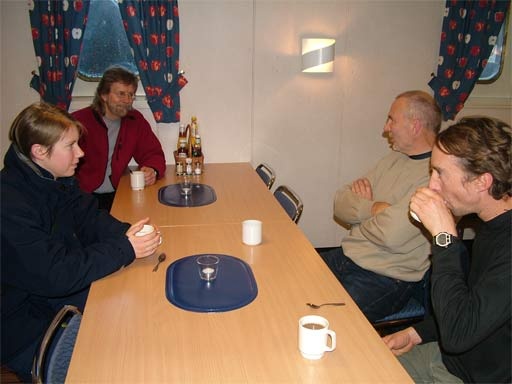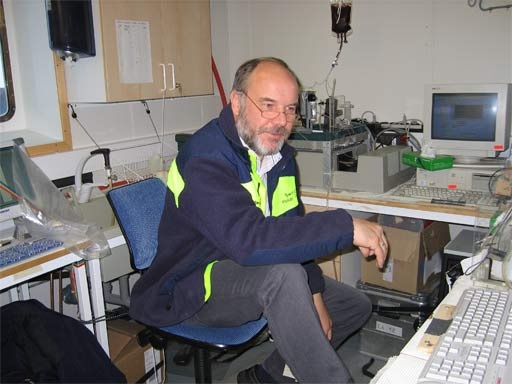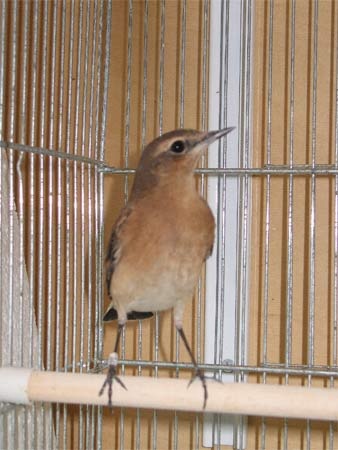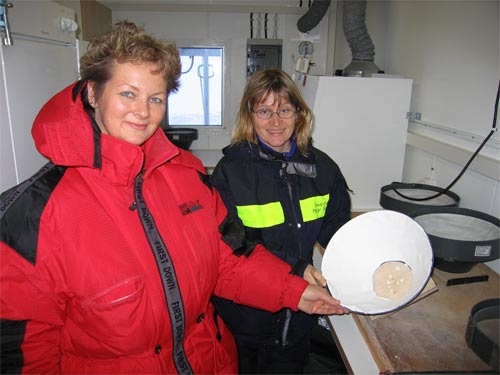( Log In ) Log In is for TREC Teachers & Researchers only
  |
| Ute_Kaden |
 Sep 20 2005, 01:05 AM Sep 20 2005, 01:05 AM
Post
#1
|
 TREC Teacher    Group: TREC Team Posts: 203 Joined: 27-April 05 Member No.: 10 |
Visiting the Swedish Icebreaker Oden
9-17-05 The ice breakers ODEN and HEALY are working their way through the ice together since September 1st. Joined science meetings and visitor exchanges are organized between the two ships. Today, Eva Gronlund, from the Swedish Polar Research Secretariat asked me if I wanted to go (fly) and visit the Oden. Oh, yes certainly. However, blowing snow and low visibility let my hopes dwindle. Will the ODEN Helicopter pilot fly under those conditions? The very experienced helicopter pilot, Sven, did. They brought a patient with tooth problems to our sickbay for surgery. ENS Keidi Niemann, Glenn Berger, Dale Hubbard and I jumped on the chopper and flew over to ODEN.  Dale, Glenn, Sven (Pilot), Ute gettiing ready to fly  inside the Swedish Helicopter  Sven, the helicopter pilot Snow was blowing over the helicopter landing area when we arrived, nasty weather conditions. We got a warm welcome on the Bridge followed by a tour of the ship. The ODEN is especially designed for ice breaking. She is in service since 1989 and made already 5 successful trips to the North Pole. Being a civilian, European build vessel the interior looks a bit cozier as the interior of the USCGC HEALY.  Keidi, Glenn, Dale, Ulf on tour of the Oden  Ulf and Dale infont of the ODEN'S bridge  Glen, Dale, and Keidi on the ODEN  cozy Oden room  coffee break on the Oden Beringia 2005, is the name of the science expedition and Oden functions as the science platform for oceanographic projects. Ulf Hedman, the logistics manager was our tour guide. We visited lab spaces and talked to scientists. Ludger Mintrop researches the carbon cycle in the Arctic. He analyzes the CO2 concentration in the sea water. “CO2 concentration is like a signature of the sea water. We can determine where it is coming from”, explained Ludger. Frank Zemlyak detects Freon in the seawater with an electron capture detector.  Ludger explains his CO2 carboncycle project We had heard that the Oden has birds onboard. Susanne Akesson from Lund University, SE, is the PI for the bird magnetic navigation project and showed us around. The birds, Northern Wheatear, live in the circumpolar regions Canada, Russia, Greenland, Alaska and migrate long distances to Africa each year in August. The question is how do the birds find their way? “We know that they are somehow genetic programmed and that they orient themselves by the declination of the Earth’s magnetic field, the sun and the stars “, Susanne said. She hopes to find out how the birds react to the special magnetic conditions near the magnetic pole of the earth. The birds get placed in a unique constructed “Emlen funnel” on the ice. They orient themselves and try to fly in a special direction. By doing so they put scratch marks on a special coated paper inside the funnel. Susanne records the patterns and the frequency. She hopes to get more information about the ability of birds to navigate over long distances.  Northern Wheatear is a long distance traveler  Susanne Akesson explains her magnetic navigation bird project.  The Emlen Funnel is used to determine the direction the bird would like to fly. The call that our Helicopter is coming to pick us up concluded the interesting ODEN visit. We like to thank the Swedish Polar Research Secretariat for the generosity to make those exchanges in the middle of the Arctic possible. Special thanks to the ODEN crew and scientists for the warm welcome and hospitality.  Oden breaks ice Best regards, Ute Kaden |
  |
1 User(s) are reading this topic (1 Guests and 0 Anonymous Users)
0 Members:

|
NSF Acknowledgment & Disclaimer | Time is now: 15th November 2024 - 10:09 PM |
Invision Power Board
v2.1.7 © 2024 IPS, Inc.








